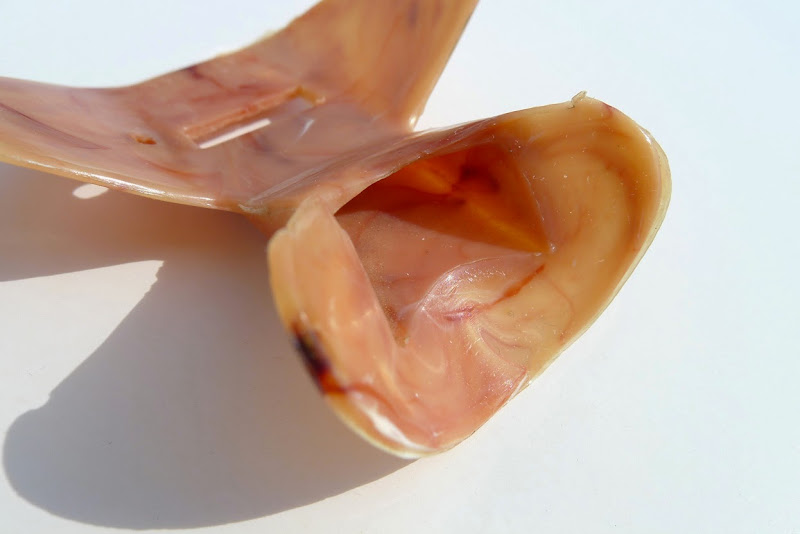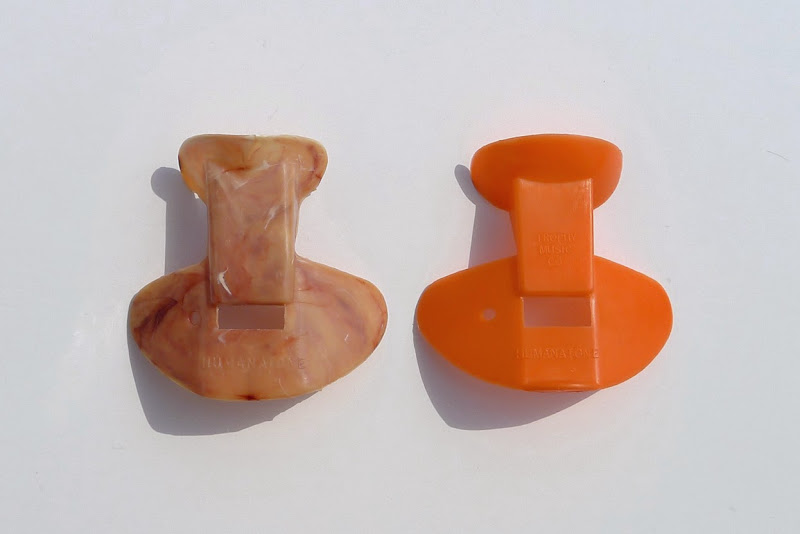
The nose flute is a plastic Humanatone branded by Gretsch, with the very original shape designed by Ernest W. Davis in his 1940 patent, which is slightly different of the current shape. The flute has a great but weird marbled color, a bit like a salmon roe with nerves and veins:)
 | |
 |  |
 | |
 | |
 |  |
 | |
 | |
 |  |
 |  |
 | |
Now, the box. The box has a graphic design rather typical of the 1940s Gretsch graphics. The top specify "IT'S A GRETSCH PRODUCT" and the user manual is printed on the back side. But... Don't you think this box is a bit big for such a flat nose flute? Look at late 1940s Humanatone packages, they are much thinner...
 | |
 |  |
 | |
Indeed, have a look at the whole spread box:

The side flaps, astonishingly, show a metal humanatone, and not the plastic one! How does it come? The box is printed with "IT'S A GRETSCH PRODUCT", and so can't be a late Stivers' Humanatone box. My hypothesis — as you know, I always have an hypothesis :) — is that when Fred Gretsch bought the Humanatone brand to the Stivers, he also bought the old stock and began to sell it with a Gretsch-branded packaging. Maybe was he waiting for the production of the new plastic nose flute. Then, when the metal nose flutes stock was out, there were still boxes printed with the metal flute, but Gretsch used them for the new plastic instruments. Then, they produced an adapted and flat packaging. Indeed, in 1944, the boxes were already showing the plastic model.
So, I can state this plastic Humanatone is a from a very early production batch, very likely from 1943 (the origins). Great find, isn't it?



Absolutely, the large box was meant to contain the metal Stivers nose flute. How curious and what a great find from a transitional period! I always love these posts where authentic originals are uncovered. Really like the magical marbled effect on those early Gretsch nose flutes.
ReplyDeleteOne thing tickles me anyway : the 1944 box shows a plastic Humanatone but is still thick... Well, that doesn't change the datation of this orange-marbled Humy.
DeleteThey must have had packages in the larger size to spare and possibly simply altered the template for the flaps. 1943 and 1944 were times of increasing scarcity, so I guess everybody made do with what they had (left). Ordering and issuing a new design box would probably have cost too much at the time, I reckon?
DeleteI'm not sure to understand.. Fact is the printing comes before cutting the cardboard to make the shape of a box. But you are right : they may have used the same "template" and cutting mask.
DeleteI think creating a new template cost too much?
Delete